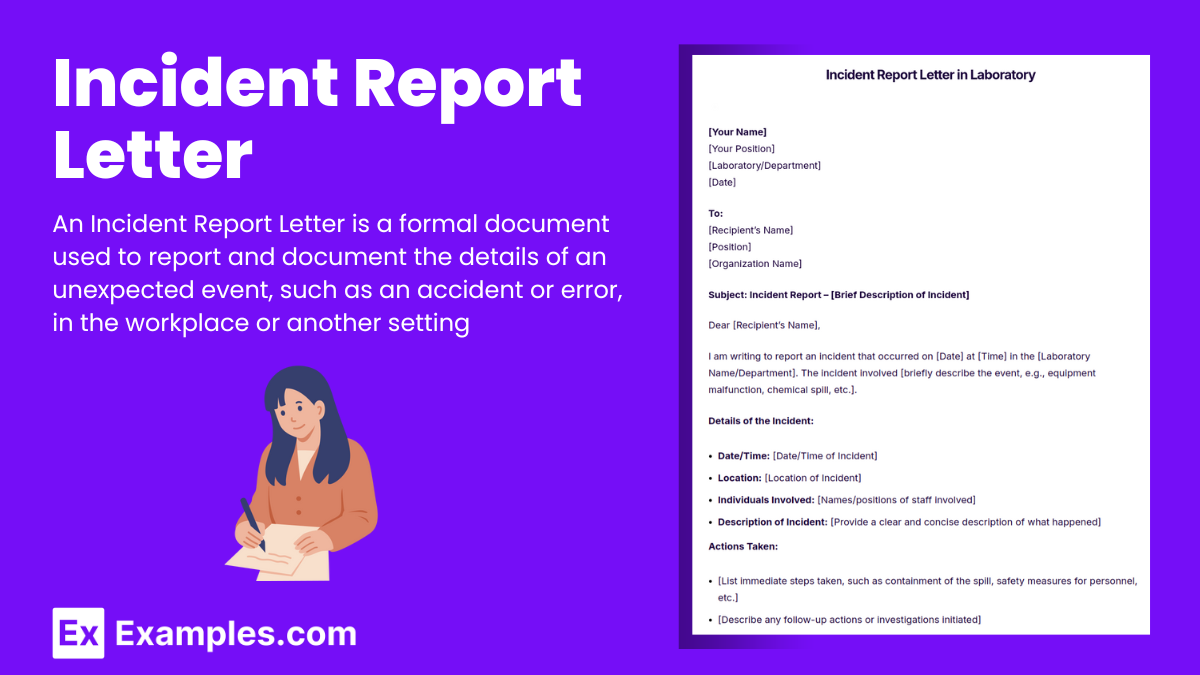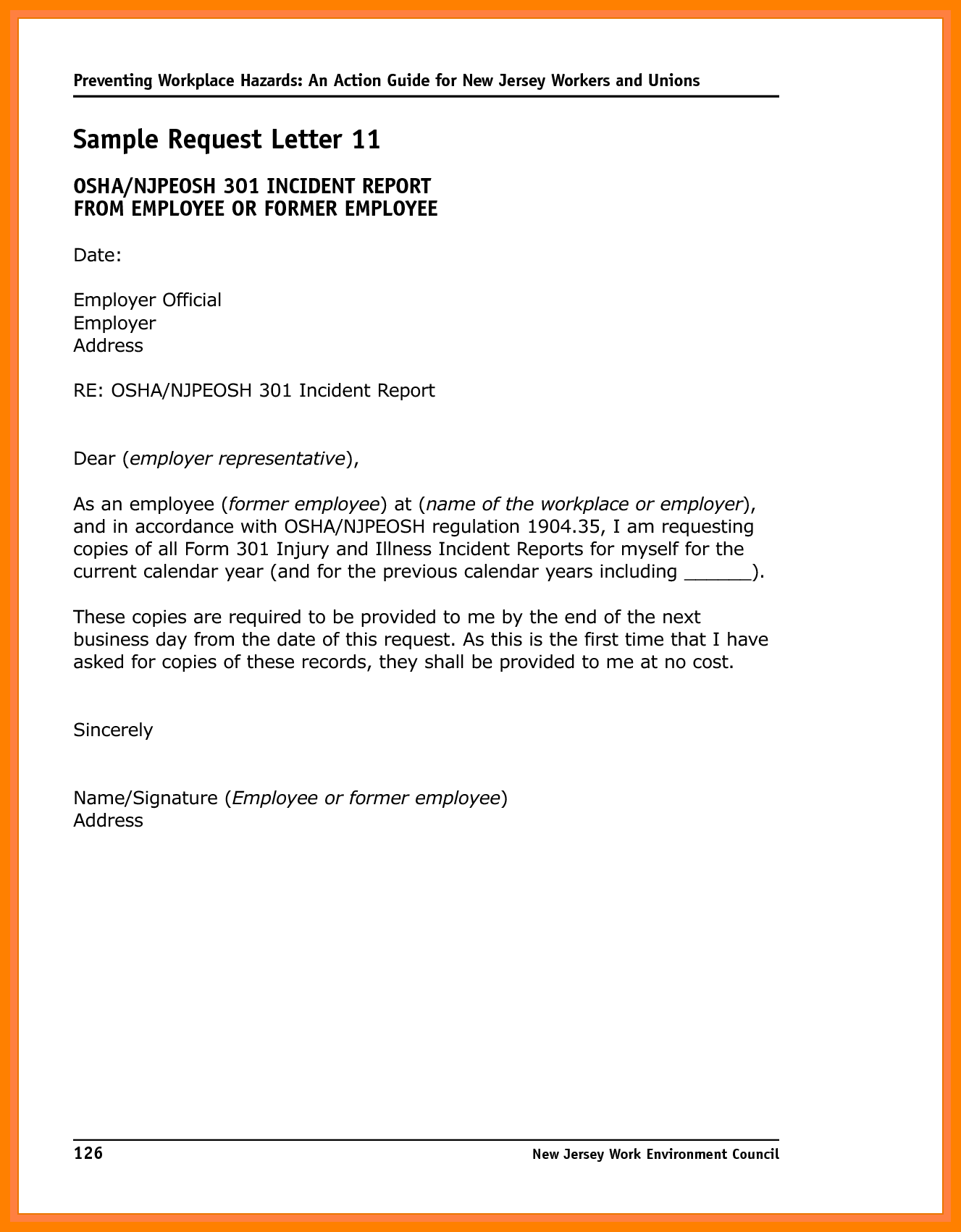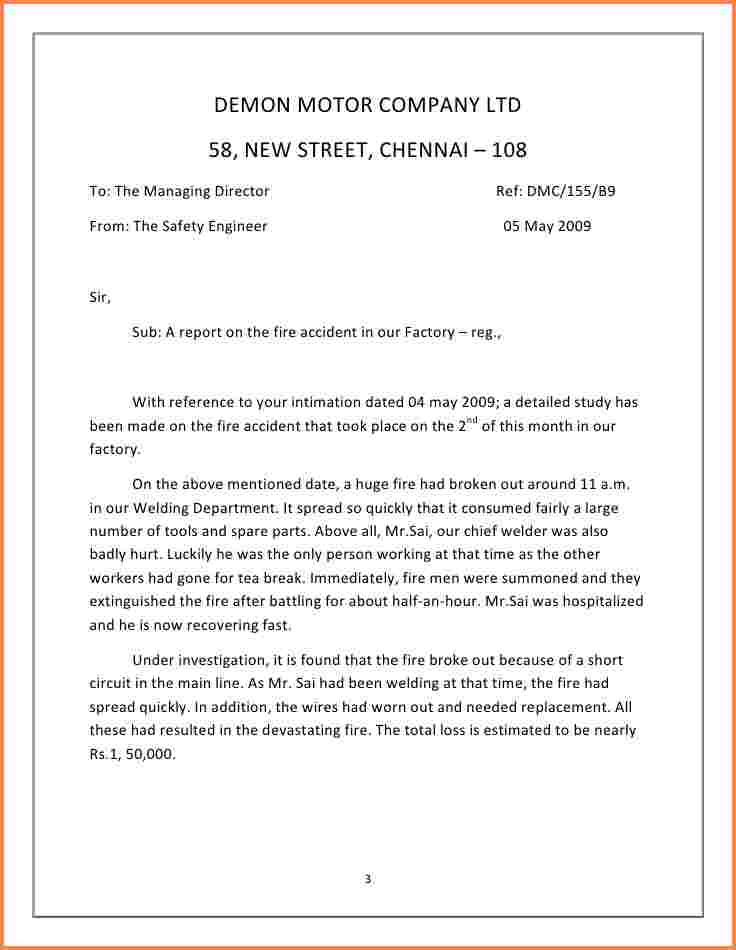12+ Incident Report Letter Examples to Download
Whenever an incident arises in a certain area or district, the local police would usually note that down in their blotter (a logbook that is often used to note the certain accident) and provide the gist of what went down in that certain accident. An incident report provides the parties concerned with a clear outlook on how the incident occurred and what can be done to prevent it from occurring again in the near future. Here is a list of templates that you can use to properly draft an incident report.
What is an Incident Report Letter?
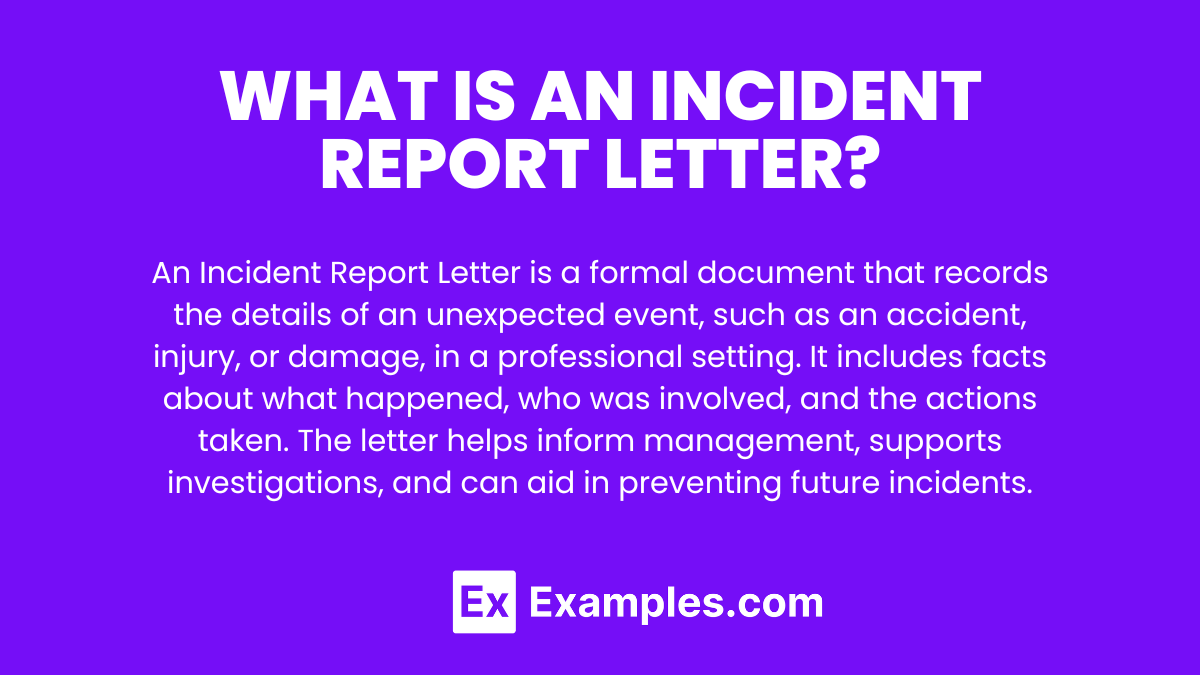

Download Incident Report Letter Examples Bundle
Incident Report Letter Format
Opening Remarks
- Greeting: Begin with a formal and respectful greeting.
- Examples:
“Dear Sir/Madam,”
“To whom it may concern,”
Introduction
- Purpose: Briefly explain the reason for writing the report.
- Example:
“I am writing to report an incident that occurred on [date] at [location].”
Incident Details
Date and Time: Clearly state when the incident took place.
Example:
“The incident occurred on [insert date] at approximately [insert time].”Location: Provide the specific location where the incident happened.
Example:
“The event took place at [insert location].”People Involved: List all individuals involved or impacted by the incident.
Example:
“The individuals involved in the incident include [names and roles].”
Description of the Incident
Explanation: Describe what exactly happened in a clear and factual manner.
Example:
“At [time], [describe the incident in detail, explaining the sequence of events].”Actions Taken: Explain any immediate actions or responses after the incident.
Example:
“Immediately after the incident, [describe any actions or interventions made].”
Witnesses
Witness Information: Include the names and contact details of any witnesses.
Example:
“The following individuals witnessed the incident: [names and contact information].”
Conclusion
- Summary: Briefly summarize the key points of the incident.
- Example:
“In summary, the incident involved [brief description] and the actions taken included [recap of actions].”- Next Steps: Outline any follow-up actions or investigations that will occur.
- Example:
“Further investigation will be conducted to assess [details of the next steps].”
Closing Remarks
- Final Note: Thank the reader for their attention and reiterate the importance of the matter.
- Example:
“Thank you for your attention to this important matter.”- Signature: End with a formal closing.
- Example:
“Sincerely,
[Your Name]
[Your Position]
[Your Contact Information]”
Best Example of Incident Report Letter
[Your Name]
[Your Position]
[Company/Organization Name]
[Address]
[City, State, ZIP Code]
[Email Address]
[Phone Number]
[Today’s Date]
[Recipient’s Name]
[Recipient’s Position]
[Company/Organization Name]
[Address]
[City, State, ZIP Code]
Dear [Recipient’s Name],
Subject: Incident Report Regarding [Describe Incident Briefly]
I am writing to report an incident that occurred on [Date] at approximately [Time] in [Location]. I was a witness to the event and wanted to provide a detailed account for documentation purposes.
Incident Details:
- Date: [Date]
- Time: [Time]
- Location: [Specific Location]
- Description: [Provide a thorough description of the incident, including what happened, who was involved, and any resulting damages or injuries.]
Actions Taken:
- Immediate Response: [Detail any immediate actions taken to address the situation, such as first aid, contacting authorities, or securing the area.]
- Witnesses: [List any witnesses or individuals present during the incident.]
- Documentation: [Mention any photographs, video recordings, or other documents related to the incident.]
Recommendations:
- Preventive Measures: [Suggest any recommendations or preventive measures to avoid similar incidents in the future.]
Please find attached [if applicable: photographs, additional documentation] for your reference.
I am available to provide further information or clarification if needed. Thank you for your prompt attention to this matter.
Sincerely,
[Your Name]
[Your Position]
[Contact Information]
Incident Report Letter in School
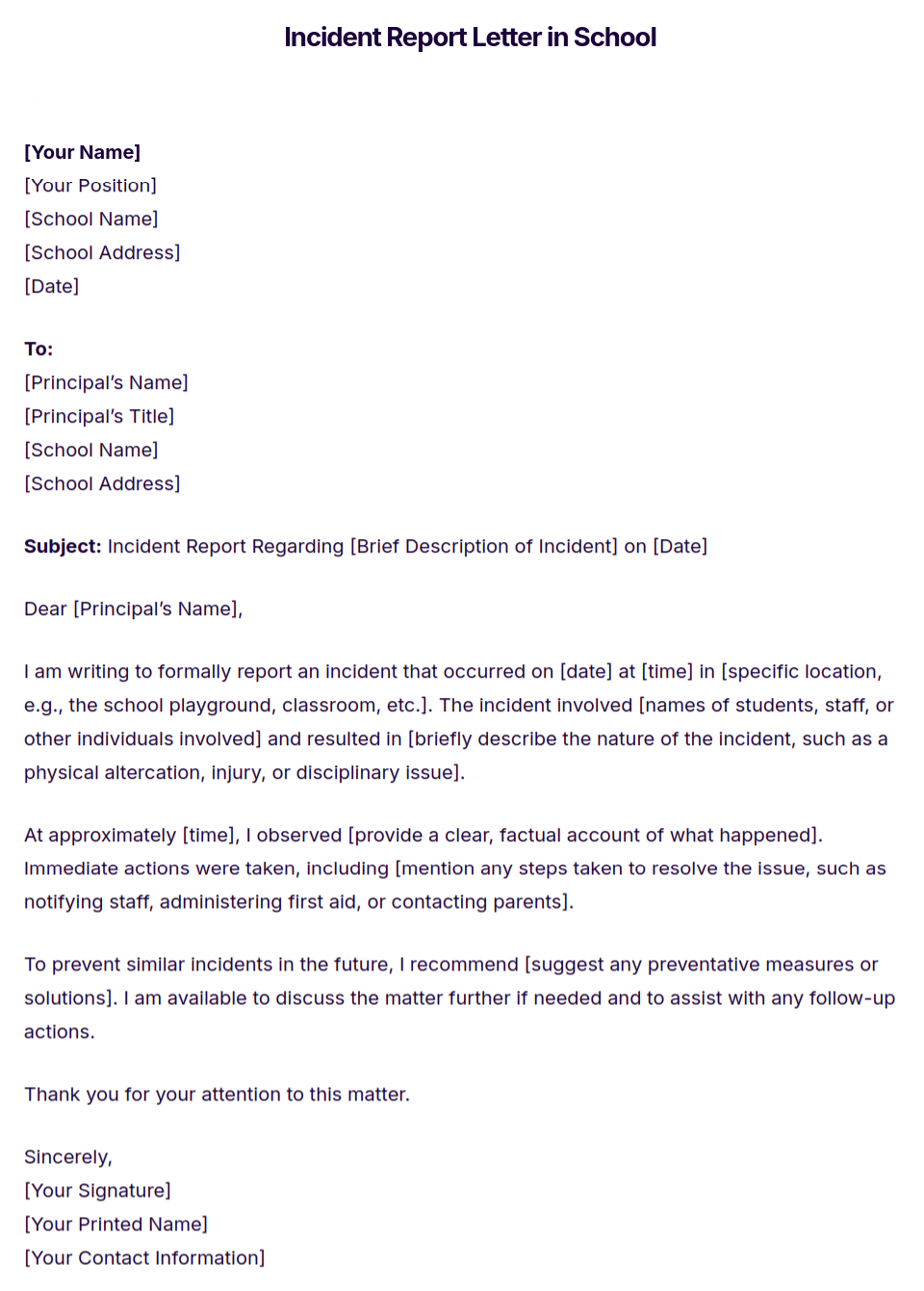
Incident Report Letter in Hospital
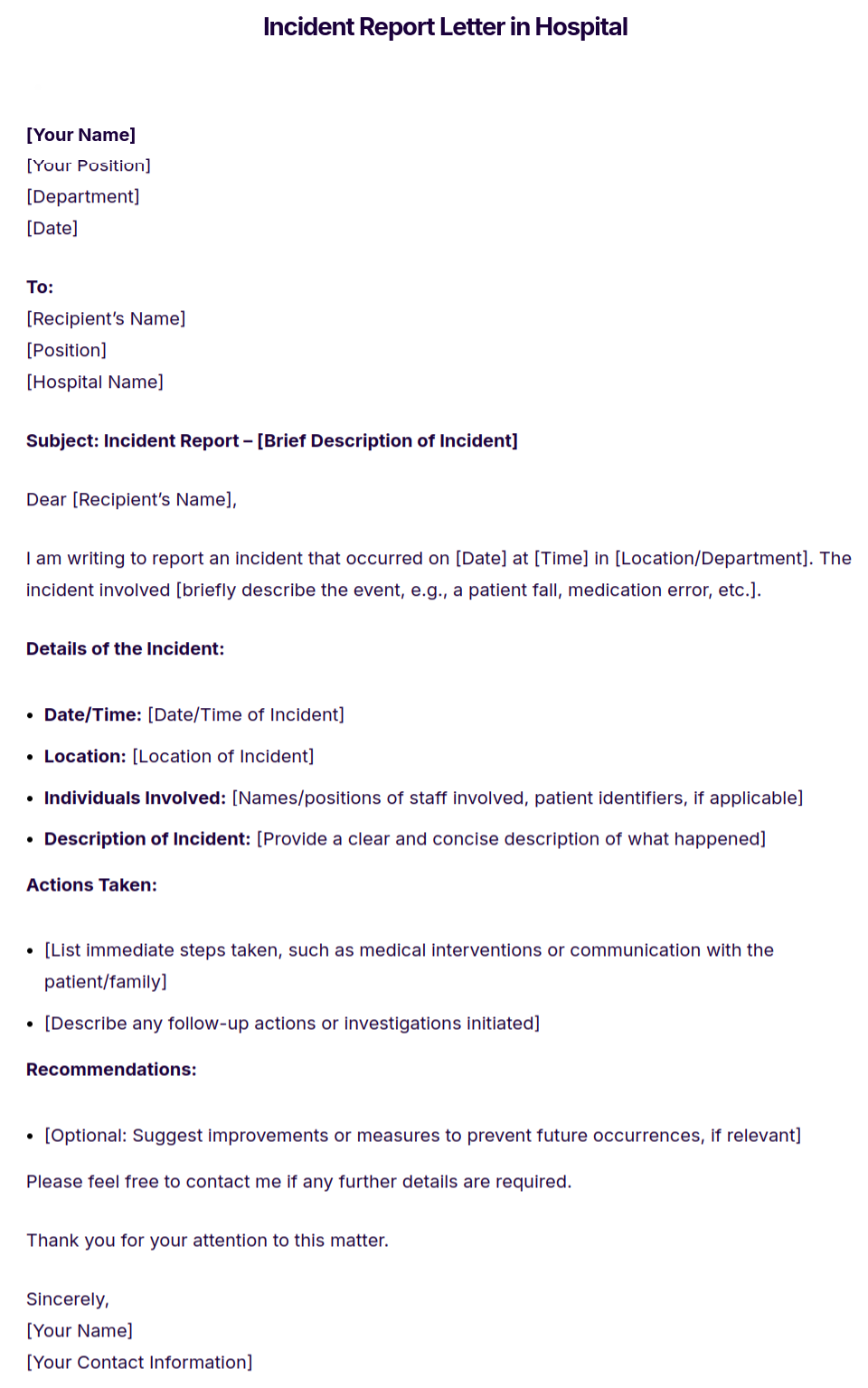
Incident Report Letter in Laboratory
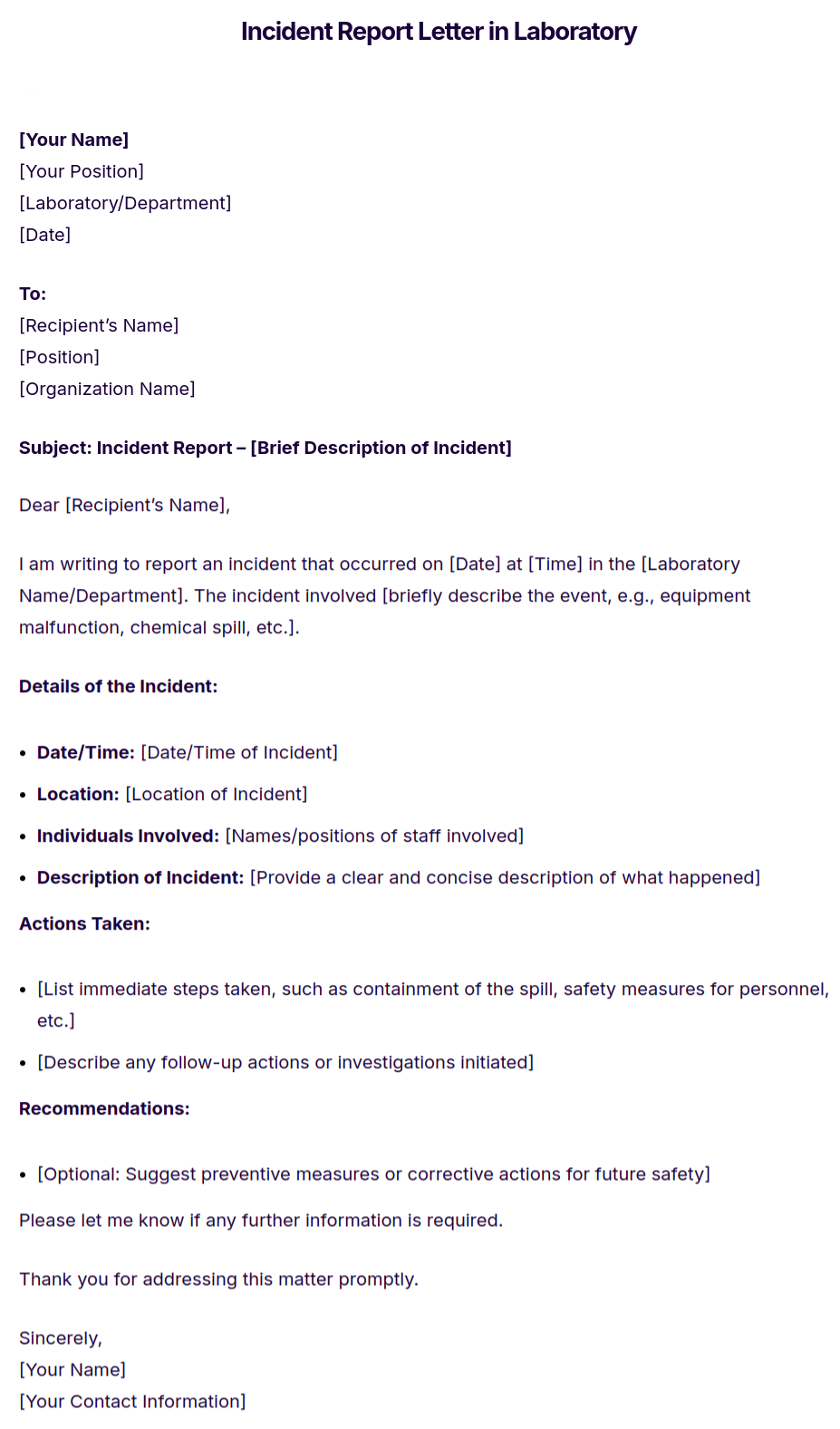
More Incident Report Letter Examples and Sample
1. Free Incident Report Letter Example
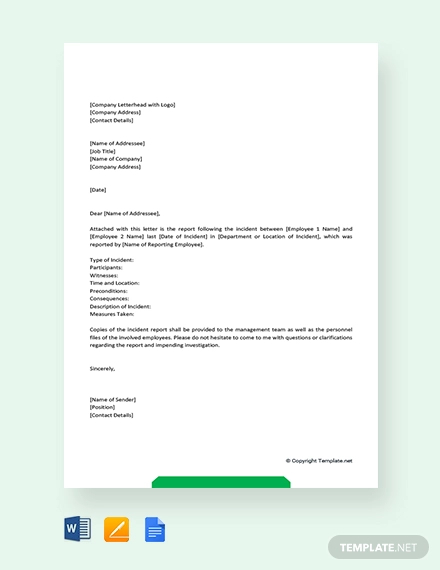
2. Free Incident Report Letter in Workplace

3. Construction Incident Report Letter Example

4. Free Incident Report Letter In Office
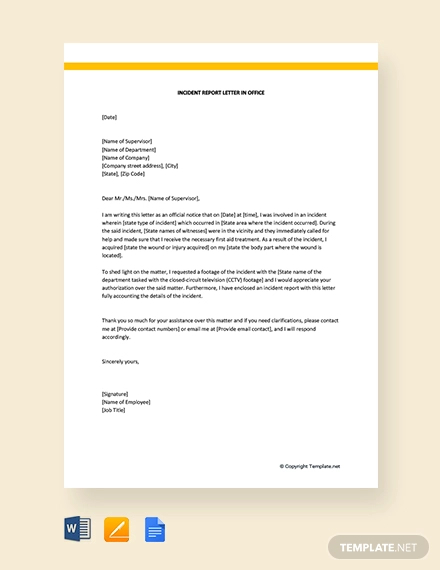
5. Employee Incident Report Example
6. Sample Incident Report Example
Checking the Report
1. Double-check the basic facts
In journalism, you would have already committed a grave sin if you reported something that you have not double-checked what your source has said. Once that article gets published, it may be retracted, but that the responsibility for getting it wrong will fall on you and you alone. It will be like you have lied directly to the public. So, make sure that your facts are right. See expense report examples & samples as well.
2. Edit and proofread your report
No one likes to read a disorganized and grammatically incorrect report. So, try to proofread and make adjustments to your report.
3. Submit your incident report.
Once you are done with your report, submit it to your designated officer or superior in-charge. Upon submission, the usual procedure will most probably involve a board meeting with all concerned parties before a resolution can be made. Take a look at the research report examples available online for more.
In an incident report, what you see is truly what you get. That’s why honesty is very crucial in making these kinds of reports so that the present administration of the organization can take action to prevent another incident like that from ever occurring again. You may also see management report examples.
How do you write an incident report letter?
An incident report letter is a formal document used to record the details of an unexpected event, accident, or incident in the workplace or any other setting.
1. Date and Your Information
- Date: Start the letter by mentioning the date on which the incident report is written.
- Your Information: Include your full name, title, department, and contact information.
2. Recipient’s Information
- Name: Address the report to the appropriate supervisor, manager, or relevant authority.
- Title and Department: Include the recipient’s title and department.
- Company Name: Mention the name of the company or organization.
- Address: Provide the official address of the company.
3. Subject Line
- Subject: Clearly state the purpose, such as “Incident Report: [Brief Description of Incident] on [Date].”
4. Opening Paragraph
- Introduction: Briefly introduce the incident. Mention the date, time, and place where it occurred. State your purpose in writing the letter—whether it’s to formally record the incident, report it to a higher authority, or request further investigation.
5. Detailed Incident Description
- What Happened: Provide a detailed and factual account of the incident. Include the following:
- Date and Time: When did the incident happen?
- Location: Where exactly did it occur?
- Who Was Involved: List the names and roles of all individuals involved in the incident (e.g., employees, visitors).
- What You Observed: Describe exactly what you saw or experienced. Stick to the facts, avoiding opinions or assumptions.
6. Immediate Actions Taken
- Response to the Incident: Describe any immediate actions taken after the incident, including medical attention provided, safety measures, or emergency services contacted.
- People Involved in Response: Mention who took the actions, such as first aid responders or security personnel.
7. Outcome of the Incident
- Consequences: State the outcomes of the incident, such as injuries, damages, or interruptions in business activities.
- Effect on Business or Individuals: Mention any significant impact the incident had.
8. Suggestions for Future Prevention
- Preventative Measures: If applicable, suggest any measures that could be implemented to prevent future incidents.
- Recommendations: Propose safety enhancements, training, or procedural changes.
9. Closing
- Final Remarks: Conclude the letter by reaffirming your commitment to helping resolve the situation. Mention your availability for further discussion or follow-up.
- Signature: End the letter with your signature and printed name.
What are the 4 types of incident reports?
1. Accident Reports
- Purpose: Document injuries or accidents involving employees, customers, or visitors.
- Examples: Workplace falls, equipment-related injuries, or vehicle accidents on company property.
2. Near-Miss Reports
- Purpose: Record incidents that could have resulted in an accident or injury but did not.
- Examples: A worker almost being hit by a falling object or a vehicle narrowly avoiding a collision.
3. Safety or Hazard Reports
- Purpose: Report unsafe conditions or hazards that could lead to accidents or injuries.
- Examples: Faulty equipment, exposed wires, or slippery floors.
4. Security Incident Reports
- Purpose: Document incidents involving security breaches, theft, vandalism, or other criminal activities.
- Examples: Break-ins, stolen property, or unauthorized access to a restricted area.
What happens when you write an incident report?
1. Documentation of the Incident
- The report serves as a formal record of what happened, when, where, and who was involved. This documentation is crucial for transparency, accountability, and accuracy in addressing the situation.
2. Investigation and Analysis
- After the report is submitted, an investigation is often initiated. Supervisors, safety officers, or HR may look into the incident to gather further details and assess the cause of the event. This can involve interviews with witnesses, reviewing video footage, or examining the scene.
3. Corrective or Disciplinary Actions
- Based on the findings of the investigation, corrective actions may be taken to address the problem. This could involve repairs, safety upgrades, employee training, or disciplinary measures if negligence or rule violations were involved.
4. Prevention Measures
- The organization may use the report to identify patterns of incidents and take proactive steps to prevent similar events in the future. This might include implementing new safety protocols, revising procedures, or conducting training sessions.
5. Legal and Insurance Implications
- If the incident involves injury, damage, or legal issues, the report can be used for insurance claims or legal purposes. It may also serve as evidence in legal proceedings or as part of compliance with regulatory requirements.
6. Review by Management
- The report will often be reviewed by management or safety committees to ensure appropriate actions are taken. It helps ensure that management is aware of risks and is actively working to mitigate them.
7. Follow-up
- Depending on the severity of the incident, follow-up actions may occur to monitor the effectiveness of corrective measures and ensure that no further issues arise.
Tips for Writing an Incident Report
- Be Clear and Concise: Stick to the facts, avoid unnecessary details, and ensure the report is easy to read and understand.
- Include Key Details: Provide essential information such as date, time, location, people involved, and witnesses.
- Use Objective Language: Avoid opinions or assumptions; report only what you observed or were told.
- Describe the Incident Chronologically: Write the events in the order they happened to ensure clarity.
- State the Facts: Be accurate with details like times, dates, names, and descriptions of the incident.
- Use Proper Grammar and Spelling: A well-written report reflects professionalism and ensures clarity.
- Include Evidence or Attachments: If applicable, include photos, videos, or any other relevant evidence.
- Ensure Accuracy: Double-check details, especially names, dates, and times, to avoid errors.
- Review the Report Before Submission: Proofread to ensure all necessary information is included and is error-free.
FAQS
1. When should an incident report letter be written?
An incident report letter should be written as soon as possible after the incident occurs. Prompt reporting ensures that details are fresh in your mind and the necessary actions can be taken quickly to prevent further issues.
2. What tone should be used in an incident report letter?
The tone should be formal, objective, and professional. Focus on stating the facts clearly without placing blame. Avoid emotional language or speculation.
3. Who is the incident report letter addressed to?
The incident report letter is typically addressed to a supervisor, manager, or relevant department head responsible for handling such reports.
4. What should I avoid in an incident report letter?
- Avoid assigning blame or making assumptions.
- Don’t use vague language; be specific about facts and details.
- Avoid including unrelated information.
- Do not exaggerate or downplay the seriousness of the incident.
5. Is it necessary to include recommendations in an incident report letter?
While recommendations are not always required, they can be helpful. If you have suggestions for preventing similar incidents in the future, include them in a separate section. However, it’s fine to leave them out if they are not relevant.
6. What happens after submitting an incident report letter?
After submitting the letter, the recipient may initiate an investigation, take corrective action, or request additional details. Depending on the nature of the incident, follow-up meetings or reports may also be required.
7. Can I submit an incident report letter electronically?
Yes, many organizations allow incident reports to be submitted electronically via email or an internal reporting system. Just ensure that all required information is included, and the letter is professional in tone and format.
8. How detailed should the description of the incident be?
The description of the incident should be as detailed as possible while remaining concise. Include all relevant facts such as who was involved, what actions were taken, and the sequence of events leading up to the incident. The goal is to provide a clear and objective account that can be easily understood by anyone reviewing the report.


